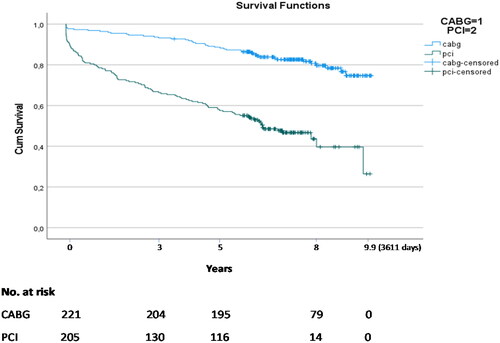Figures & data
Figure 1. Flow chart from the Noble study. As shown, 5 of the 36 centers including patients in the randomized trial assigned the planned registry for non-randomized patients. CABG: coronary artery bypass surgery; PCI: percutaneous coronary intervention; MI: myocardial infarction. *Six received CABG as index treatment and seven received no index treatment. †26 received PCI as index treatment and seven received no index treatment. Used with permission from the publisher (Elsevier Inc). Adapted from Lancet 2016; 388: 2743–2752 (https://doi.org/101016/50140-6786(16)32052-9).

Table 1. Parameters used to define risk factors for mortality in the analysis.
Table 2. Risk factors in patients treated with PCI or CABG calculated difference between groupsa.
Table 3. Mortality at the end of the 3611 day (9.9 years) observation period in patients with low (score table 1 < 6) or high (score table 1 > 5) clinical risk profile.
Figure 2. Kaplan–Meier survival curves for patients treated with PCI or CABG. All patients in the registry are identified in the Norwegian Registry for Public Health (Folkeregisteret) with a complete track of death dates in the population. Censored data (vertical bars) therefore mean observation time for patients still alive at the assessment date of 20 October 2020. The longest recorded observation period was 3611 days or 9.9 years. Log Rank test: p < .001.

Table 4. Cox proportional hazard model showing independent variables with significant effect on mortality with their corresponding hazard ratios (Exp(B)).
Data availability statement
Data are partly from the Noble Study. Data used in the present publication are pseudonymized and kept in an accessible file at the hospital research server. Data from electronic patient records are restricted from distribution by Norwegian law (https://lovdata.no/dokument/NL/lov/2014-06-20-43). Approval was obtained from the Regional Ethics Committee (REK 2459-5/2010).
